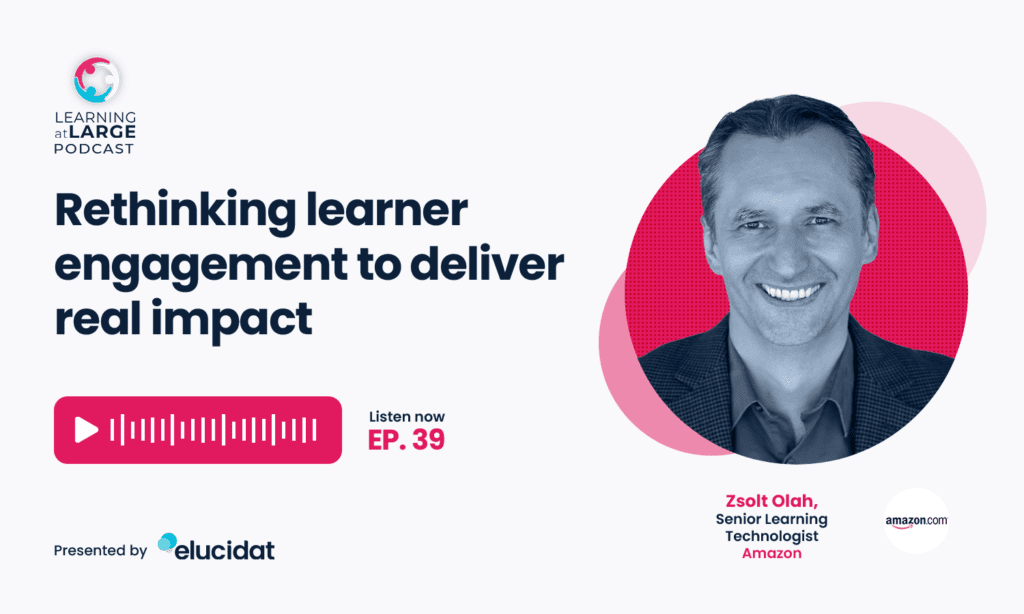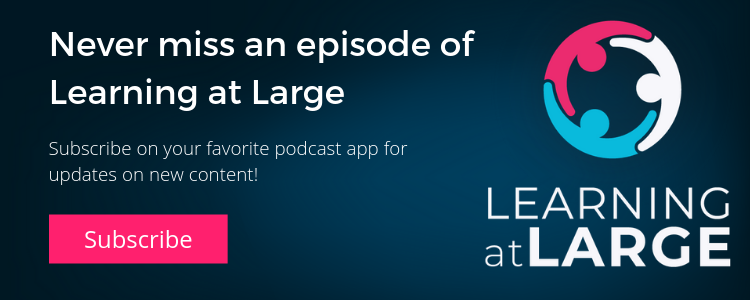Rethinking Learner Engagement To Deliver Real Impact
Learning doesn’t exist in a bubble. From daily tasks to urgent deadlines, lots of things are competing for employees’ time. So, how can you get their attention and create real business impact? Hear how Zsolt Olah, Senior Learning Technologist at Amazon, is rethinking end user engagement. Explore how to dig deeper so engagement translates into real world impact.

Top tips to create engagement with impact
Don’t have time to listen now? Here are some top tips from Zsolt:
- Don’t see engagement as an add on: Embracing the latest L&D trends won’t lead to real engagement. Instead dig deeper to understand how you can achieve impact.
- Look to psychology to understand motivation: Understand how your employees really experience things and you can identify what motivates them.
- Respect your learners’ time: People are busy and under pressure to perform. Make sure L&D is providing relevant and timely support, rather than distraction.
- Be part of a social contract: Play your part in effective learning and development by looking at the bigger picture and working in collaboration.
1. Don’t see engagement as an add on
Innovation and creativity are a vital part of effective learning and development. But the desire for new, exciting approaches can lead to L&D unquestioningly embracing the latest learning trends.
Zsolt sees L&D efforts and expertise often being focused in the wrong direction. Time and budget are invested in spicing up learning experiences or adding interaction to digital learning. While it’s assumed this will automatically create engagement, it actually may have little impact or even distract from the learning.
“Labels are killing the industry. You go to a conference, read a blog, go to a TED Talk, and see something exciting that’s going solve your problem. Instead of diving deeper into the research of what does that actually mean…you just grab the label, and stick it onto your learning. Take your long, boring course, cut it into four pieces and you have microlearning. You say, ‘I’m gonna give you five points, if you watch this boring video’ and now you have gamification.”
2. Look to psychology to understand motivation
Instead of believing that buzzwords will be the answer to issues with end user engagement, Zsolt looks to psychology.
Whether someone has just completed a short course or is on a longer learner journey, understanding how their engagement is triggered is key. Emotions are not pre-wired. You can’t control these reactions. It’s all constructed based on a person’s life experience. And knowing this can help you take a more critical approach to your learning design and how you measure your success.
“Psychology shows that we remember the hype of things – the funniest or extremist part – and the things at the very end, but then everything else gets lost. And so that evaluation data itself is not really good enough to go back and improve the learning experience. Not to mention that there’s no correlation between engagement or satisfaction and application on the job or moving the needle.”
3. Respect your learners’ time
Understanding what motivates your people is critical for producing effective L&D. When people say that they have no time to learn, they’re not saying they don’t want to learn. They’re saying that they don’t want to waste their time on things that aren’t related to their job right now.
For Zsolt, there is nothing more demotivating for busy employees than L&D that’s irrelevant or not provided at the point of need.
“I was put into this development program to become a senior program manager. I came from a hardcore project management background, but part of his program was that you have to learn all these things again. It was boring. It was demotivating. Because I already knew it. And that’s our biggest problem. Today we have the technology to actually understand where you are with your skill set, where you want to go, so we need to provide you the shortest way to get there.”
4. Be part of a social contract
L&D don’t own learning. Zsolt sees it as a social contract. Everybody has a part to play if learning is going to be successful. Your organization needs to provide the structure, time and incentives that enable effective career development. Managers should offer support and direction. The employee themselves need to be actively engaged in the process.
You need to focus on this bigger picture. By interrogating the problem and understanding the circumstances people operate in, you can identify the behaviours you need to motivate with your learning solution.
“L&D is not responsible for learning. Learning happens in someone’s brain. Our job is to provide the best conditions based on science and not myth and labels. That doesn’t mean, we’re going to give you courses. It means that we’re going to understand what your problems are, and then provide you tools. And that may be a course, but it could be a simple checklist.”
A quick recap
Lots of things are vying for your employees’ attention. If you’re going to engage your people and create real business impact, Zsolt has four strategies that can help. Don’t just look to the latest L&D trends for an engagement add on. Explore psychology to understand what motivates people. Treat your employees’ time with respect by providing relevant learning at the point of need. Always look at the bigger picture and work in collaboration to solve the real business problem.
Want to find out more? Check out the full podcast.
About Zsolt
With over 20 years’ experience in technology and learning, Zsolt is passionate about empowering people to get the job done. He’s a champion of less content, more impact.
You can find out more and get connected with Zsolt Olah on LinkedIn.
On Zsolt’s reading list
Find out which books are influencing Zsolt’s thinking on engagement.
Surprise: Embrace the Unpredictable and Engineer the Unexpected, Tania Luna, Leeann Renniger
Zsolt sees surprise as an essential part of creating effective motivation to learn. Surprise is the key that unlocks growth, innovation, and connection.
How Emotions Are Made: The Secret Life of the Brain, Lisa Feldman Barrett
Emotion is constructed in the moment aided by a lifetime of experiences. This book provides insight into what you can and can’t influence to motivate people.
Looking for more reading tips? Check out our book blog.
Join the conversation!
We’d love to hear your thoughts on our podcast, so feel free to get in touch with our podcast host, at kirstie.greany@elucidat.com. As always, don’t forget to subscribe to Learning at Large in your favorite podcast app and leave us a 5-star rating if you enjoyed it. Thank you for joining us, and see you next time.
